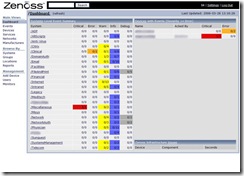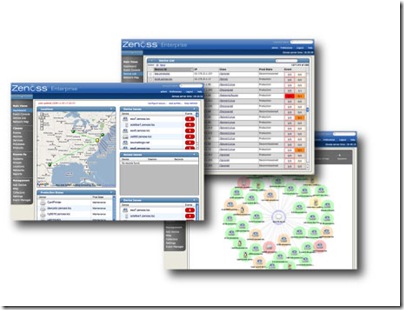 Zenoss (Zenoss Core) is an open source application, server and network management platform based on the Zope application server. Released under the GNU General Public License (GPL) version 2, Zenoss Core provides a web interface that allows system administrators to monitor availability, inventory/configuration, performance and events.
Zenoss (Zenoss Core) is an open source application, server and network management platform based on the Zope application server. Released under the GNU General Public License (GPL) version 2, Zenoss Core provides a web interface that allows system administrators to monitor availability, inventory/configuration, performance and events.
Erik Dahl began Zenoss development in 2002 and in August 2005 founded Zenoss, Inc., with Bill Karpovich. Zenoss, Inc. sponsors the development of Zenoss Core and sells an enterprise version based on the core version.
Project Milestones
Zenoss maintains an active developer community. Notable project milestones include:
2002
Erik Dahl began development on Zenoss.
August 2005
Erik Dahl and Bill Karpovich form Zenoss Inc.
March 2006
Zenoss made available on SourceForge.net.
November 2006
Zenoss Core Version 1.0 released.
June 2007
Zenoss Core 2.0 released.
July 2007
Zenoss Enterprise 2.0 released.
October 2007
Zenoss Core 2.1 released.
November 2007
Zenoss Enterprise 2.1 released.
May 2008
Zenoss Core 2.2 released.
Nov 2008
Zenoss Core 2.3 released.
May 2009
Zenoss Core 2.4 released.
Oct 2009
Zenoss Core 2.5 released.
Technology Overview
Zenoss Core combines original programming and several open source projects to integrate data storage and data collection processes with a web-based user interface.
According to the project's web site, Zenoss Core is built upon the following open source technologies:
* Zope Application server: An object-oriented web server written in Python.
* Python: Extensible programming language.
* Net-SNMP: Monitoring protocol that collects systems status information.
* RRDtool: Graph and log time series data.
* MySQL: A popular open source database.
* Twisted: An event-driven networking engine written in Python.
Zenoss Core provides the following capabilities:
* Monitoring availability of network devices using SNMP, SSH, WMI
* Monitoring of network services (HTTP,POP3,NNTP,SNMP,FTP)
* Monitoring of host resources (processor, disk usage) on most network operating systems.
* Time-series performance monitoring of devices
* Extended Microsoft Windows monitoring via Windows Management Instrumentation using SAMBA and Zenoss open source extensions
* Event management tools to annotate system alerts
* Automatically discovers network resources and changes in network configuration
* Alerting system provides notifications based on rule sets and on-call calendars
* Supports Nagios plug-in format
Platform
Zenoss Inc. lists the following operating systems for Zenoss Core on their download page:
* Red Hat Enterprise Linux / CentOS (4, 5)
* Fedora (9, 10, 11)
* Ubuntu (6.06, 8.04)
* Debian (5)
* SuSE (10.X)
* OpenSUSE (10.3, 11.1)
* Mac OS X (10.5 Intel, PPC from source, 10.6)
* VMWare Appliance
* FreeBSD (6.x and 7.x from source)
* Solaris (10 from source)
* Gentoo (from source)
Other Linux versions will work with the stack installers as well as source for any other Unix systems.
A web-based portal provides operating system agnostic access to configuration and administration functions. Both Firefox and Internet Explorer are supported.
ZenPacks
ZenPacks provide a plug-in architecture that allows community members to extend Zenoss's functionality. Mark Hinkle writes in a Zenoss blog entry that anyone can write a Zenpack, and authors are free to choose how they license their individual ZenPacks. As an incentive to buy the enterprise version, Zenoss, Inc. may develop ZenPacks that are available only to enterprise users. Zenoss, Inc. chooses to release the Zenpacks included with Zenoss Enterprise as shared source, which means users can modify the code but not distribute the changes.
Enterprise
The enterprise version builds on the core version by providing commercial support and additional features, such as synthetic web transactions and global dashboards. "In the enterprise edition," writes Sean Michael Kerner, "Zenoss is adding something it calls end-user experience monitoring which is intended to more accurately simulate end-user application activity." Kerner continues, "Enterprise users also get certified application monitors specifically geared for Microsoft SQL and Exchange."
Zenoss competes with other open source and proprietary enterprise systems management products. Open source systems management products are available from GroundWork Open Source , Hyperic and openQRM . (See the OpenQRM web site). In an interview with Jack Loftus of SearchEnterpriseLinux.com, Bill Karpovich explains what makes Zenoss different:
"Companies like GroundWork are similar to the Red Hat approach, where a company gathers up the pieces and puts support behind it. Our approach is we have always had the code and we are in control of its roadmap and indemnification. The Hyperic model is where a company comes from a commercial background and makes some of the code open source."
The traditional, closed-source vendors include industry veterans BMC, HP, and CA.
If you liked this article, subscribe to the feed by clicking the image below to keep informed about new contents of the blog:









0 commenti:
Post a Comment